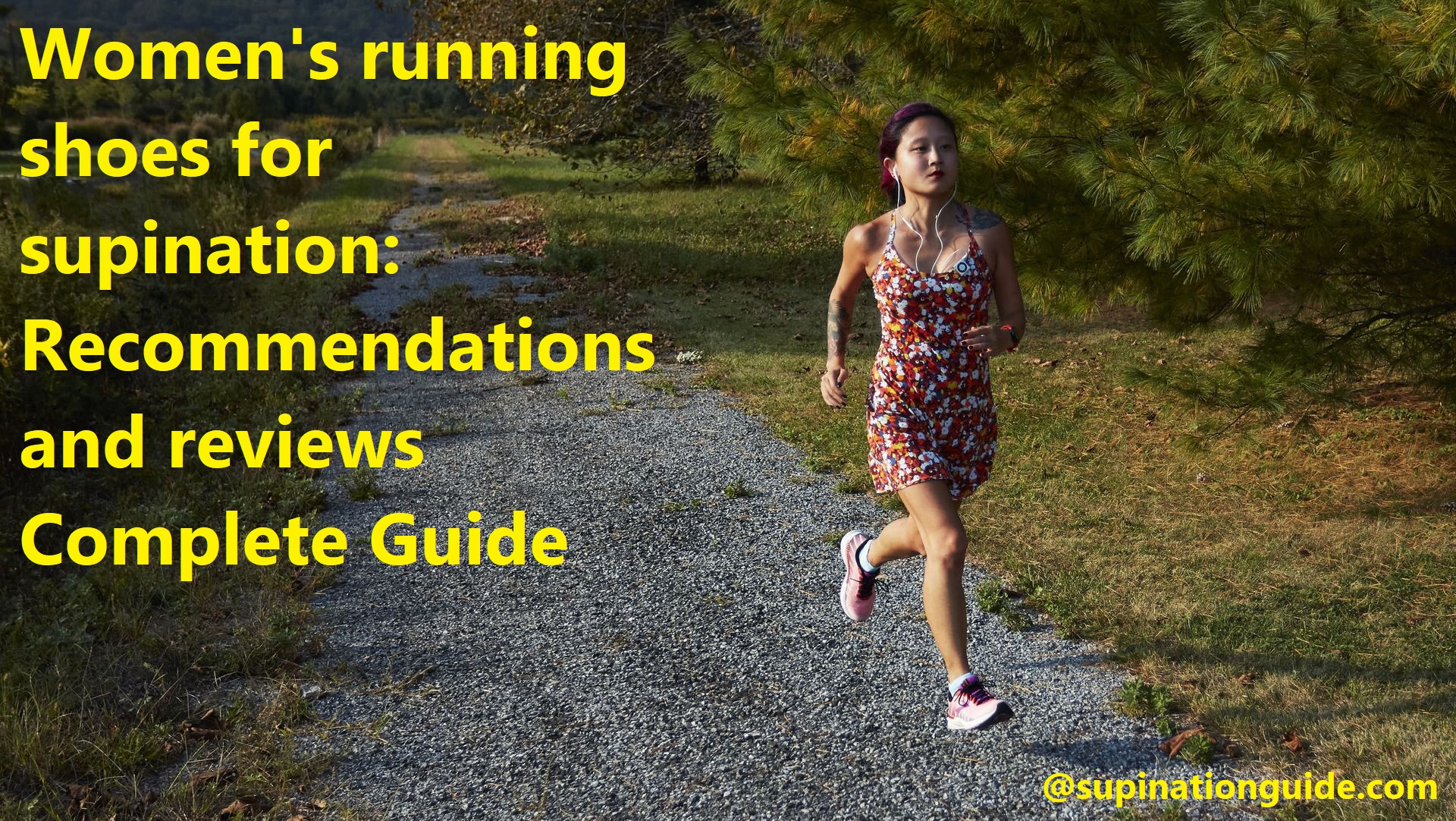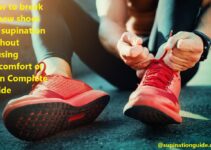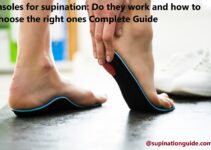Are you looking for the best women’s running shoe to reduce your supination? You’re in the right place.
In this guide, we provide up-to-date reviews and recommendations on running shoes tailored to your needs. Enjoy a comfortable, pain-free running experience with our curated selection of women’s running shoes!
Today’s runners often find themselves in the pursuit of finding a running shoe that provides comfort and stability while promoting healthy foot mechanics. Supination, otherwise known as underpronation, is a common foot condition in which the runner’s heel rolls outward and the foot pushes off from outside edge as they run. It is important for runners with supination to find a supportive shoe that will help to shift weight toward the inner edge of the foot while cushioning against impact.
In this guide, we provide reviews of some of the best women’s running shoes for supination to help you determine the perfect pair for your needs. We also include information about pronation and how it affects running mechanics, along with what features you should look for when choosing a shoe specifically designed to accommodate an underpronated form.
Explanation of what supination is and its effects on running
Supination is a term used to describe the outward rolling motion of the foot during an activity such as running. When the foot rolls outwards, less stress is placed on the inside edge of it while more pressure is put on the outside edge. This can lead to a number of issues, such as ankle instability, shin splints, and Achilles tendonitis.
To address these issues and prevent potential injuries, runners who supinate tend to require specific types of running shoes with special features to help provide arch support and stability. The most important factor when choosing running shoes for supination is finding a pair that will encourage proper biomechanics. That includes having enough cushioning for shock absorption and providing motion control or stability where needed.
The best running shoes for supination should also provide good support along the length of the foot so as not to impede natural movement while still providing stability and cushioning throughout. Shoes designed specifically for those who need pronation control may be too stiff or constraining while those designed for those who are neutral may not be supportive enough in areas that require extra reinforcement. Look for features such as cushioned midsoles with deep heel cups, forefoot flex grooves, arch supports, straps spanning across midfoot areaand two-layer midsoles with stiffer outer layers. Ultimately, you want your shoes to be comfortable as well as effective in encouraging correct biomechanical alignment during activity so take your time making sure they check all essential boxes before making any purchase decisions.

Understanding Women’s Running Shoes for Supination
Conscious buyers should familiarize themselves with the features and benefits of women’s running shoes for supination. By gaining a deeper understanding of how this footwear works, you will be better equipped to make informed purchases.
Women’s running shoes for supination have an additional layer of supportive cushioning on the outside edging of the sole. The main purpose is to provide enhanced stabilization around the forefoot area, which helps reduce stress on ankles and promote natural pronation with each step. Other common features include moisture-wicking fabric linings, rounded toe boxes and breathable uppers designed to keep your feet cool and dry during long runs. Depending on the brand and style, some may have removable insoles or custom lacing options for more personalized comfort. Many also have rubber outsoles that provide extra traction and durability when running on wet or icy surfaces.
Explanation of the key features that make running shoes suitable for supination
When selecting a running shoe to address supination, it is important to consider the key features that are found in shoes specifically designed for this condition. There are several features that can make running shoes better suited for supination and ensure the highest level of comfort and performance.
First, look for a shoe with plenty of cushioning to absorb shock. This padding is necessary to provide extra support when pronating too much during a run. Look for shoes with cushioning on both the inside and outside of the midsole as this helps to soften every step and allows feet to roll inward properly.
Second, look for a shoe with a midfoot support system such as an arch bridge or heel cup that can provide better stability and control the overpronation caused by supination. A secure fit is also important, so velcro straps or lacing systems that can be adjusted easily can be helpful. Shoes should also feature plenty of breathable mesh material so your feet stay cool and comfortable while running longer distances.
Finally, look for shoes specifically made from ultra-durable materials such as rubber outsoles that keep their traction when wet, help disperse shocks throughout every stride, and can hold up over time without weakening or cracking due to overuse. It’s always best practice to test out different shoes in-store before making a purchase in order to get an accurate gauge of how the running experience will be affected by the new gear you’re looking at buying.
How to identify supination in women’s feet
Supination is a medical term describing an outward rolling motion of the foot on contact with the ground. This type of motion often results in an incorrect stride or gait, causing pain in the tendons and muscles, as well as wear and tear on the wrong parts of your shoes. But with some helpful guidance, you can identify if you have supination and find the perfect running shoe to support your feet.
Women’s feet have several unique characteristics that may indicate they are pronating more than they should be. An easy way to check is by looking at your footprint when stepping out of a pool or shower – if it’s narrow with very little arch, then you may be supinating. Other signs include discomfort in the ankle area when running or wearing ill-fitting shoes, weak ankles due to overstretching ligaments and inadequate cushioning when standing for long periods of time.
If you think you might be suffering from pronation issues, visit your local podiatrist for an accurate diagnosis and advice on how to correct it. They can also recommend appropriate running shoes for supination that offer extra support specifically tailored to this condition. Knowing which types of shoes will work best for your feet will ensure that any running or sports activity is enjoyable and free from pain or discomfort.
Different types of running shoes for women with supination and their benefits
Women who have supination need more specific running shoes to protect their feet and reduce injury risks. Different types of running shoes have different features that provide women with the support they need to help reduce the strain placed on their feet while running. These differences can affect the overall performance, comfort level and injury prevention benefits.
Running shoes for women with supination are usually cushioned or stability models that offer a combination of cushioning and flexibility for added shock absorption. The midsole should be designed with lightweight EVA foam or similarly light material to reduce weight without sacrificing quality, support or stability. The ideal outsole should also provide good traction while still allowing the shoe to bend naturally with the foot’s movement. Many shoes also feature curved last designs and specialized fit systems that accommodate a variety of foot shapes.
Cushioned running shoes: Cushioned running shoes are designed to offer maximum shock absorption and cushioning making them perfect for runners who spend long hours on their feet training for races or marathons. The cushioning should be responsive enough to provide support but also gentle enough to allow your feet natural movement so you can stay injury-free during your runs.
Stability running shoes: Unlike a regular pair of running shoes, stability jogging kicks provide extra arch supports which help correct pronation issues such as heel rolling inwards when hitting the ground from lace-up design to the specially designed bottoms which provides extra stability so there is no over pronating when walking or jogging. This type of shoe works better for female runners with higher or flatter arches as well since it helps support those high/flat arches which tend to make it more prone pronation problems in general due has less cushioning than regular ones but more arch support instead so ultimately you will be able to enjoy greater comfort and safety during your runs than with any other type of shoe available in market today.
Factors to Consider When Buying Women’s Running Shoes for Supination
When you’re looking for the best women’s running shoes for supination, there are some factors that you should consider to ensure that you get the perfect pair of shoes. These include the type of cushioning, support, fit and stability offered by the shoes.
The type of cushioning in a shoe can affect how comfortable it is to wear and run in. Generally speaking, shoes that feature special foam or gel cushioning may be more comfortable and offer more shock absorption than traditional foam and mesh options.
Support is another important factor when it comes to finding the best women’s running shoes for supination. You want your shoe to provide you with added support in areas such as arch support, arch stretch, Achilles heel cup and ankle brace which will help reduce any pain associated with running activities.
You also have to take into account the fit of your shoe. Shoes that are too tight can cause rubbing or blistering during long runs; whereas shuffles that are too loose can affect your performance due to lack of stability. Therefore, it is important to make sure that your shoe fits properly – not too loose or tight – so you can feel comfortable while running without compromising on performance or comfort levels.
Finally, having adequate stability within a shoe increases its lifespan and provides better protection on longer runs. Shoes with additional features such as motion control technology, TPU midsole cradle or stabilizing wedges can all dramatically improve how stable a shoe is on your feet while you are running – especially if you commonly experience supination problems whilst on a run!

Importance of proper fit
When it comes to finding the right women’s running shoes for supination, one of the most important considerations is fit. In order to find a shoe that offers comfort and support while running, it is highly recommended to go in-person to a store that specializes in women’s athletic footwear. Here, you will be able to determine your own size by having your feet measured and avoid ordering the wrong size online, which can lead to unwanted returns or exchanges. Additionally, this will also give you the opportunity to try on different brands and compare their construction for a better understanding of what feels best for your foot type and needs.
Having properly fitting shoes does not just depend on length alone; instead, there are a few other parameters you should pay attention too. Arch support is key when it comes to running shoes since having inadequate cushioning or non-flexible sole materials can lead to discomfort or injury over time. You may need extra cushioning depending on the pronation or supination of your feet as well as heel heights for maximum comfort over long distances. Furthermore, fit also refers to how much space there is between your toes and the shoe body’s toe box as well as width adjustments with lacing system so that movement feels unrestricted during running sessions.
Cushioning and support
Understanding the needed cushioning and support for your running routine is an important step in choosing the right running shoe. For runners with supination, choosing a running shoe that offers extra cushioning and stability on the outside of the heel is recommended. Cushioning often comes in two forms, namely responsive foam-based cushioning and energy-return cushioning.
Responsive foam-based cushioning helps absorb shock as you run using a single foam material whereas energy-return cushioning absorbs shock while returning energy back with each step.
In terms of support, a number of shoe models offer stabilizing technology that’s built into their uppers or midsoles. This technology helps reduce pronation by providing extra support to those areas of your foot where you need it most. Additionally, some models have arch stabilization features that prevent your arch from collapsing during your run or activity level. If you’re looking for increased stability in a lightweight design, look for shoes that are categorized as Neutral Stability shoes— these often provide maximum flexibility and allow your foot to move naturally from one point to another without feeling overly constrained.
Arch support and stability
Good arch support and stability are must-haves for runners with supinated feet, as the outward-turning of the foot may cause them to lose their balance during runs more easily than their neutrally-footed counterparts. While cushioned shoes provide more comfort, stability is key when dealing with supination.
It is recommended that individuals with supinated feet opt for a lightweight shoe with better midsole cushioning, integrated heel cushioning, one that has an asymmetrical lacing pattern to decrease tension on the sides of the foot and helps create a firmer midfoot wrap. Additionally, it is recommended that runners invest in shoes that include added arch support through arch pods or multiple layers of foam to lock their feet in place.
Lastly, look for shoes made with forefoot flex grooves and an engineered outsole for flexibility and grip during dynamic movements.
Durability and flexibility
When searching for a pair of running shoes that support supination, durability and flexibility are key elements to consider. Durability is an important factor for runners – wearing down a sole can cause discomfort and can make it difficult to achieve the ideal running form. Flexibility ensures that the shoe matches the natural movement of each foot’s gait cycle, as well as avoiding injuries from occurring due to excessive rigidity. With this in mind, here are some of the features we look for when assessing running shoes:
-High quality rubber – this is especially important if you’re a heavier runner – it provides improved durability and helps ensure your soles don’t wear too quickly.
-Lightweight construction – lighter shoes give you the ability to move around quickly and comfortably, while still providing cushioning and support.
-Flexible sole–The right sole will provide cushioning along with full range of motion. Some runners also prefer forefoot cushions built into their shoes which will absorb impact as well as provide an extra layer of protection while promoting toe splay which helps supination.
-Supportive upper–Look for supportive synthetic uppers that hug your feet without being too stiff or restrictive – breathable mesh is important for hot summers. You might also want to look for secure bands around the tongue or lacing systems that allow you to customize fit easily.
Conclusion
Finally, a pair of running shoes that provide good motion control and cushioning for runners who supinate is essential to preventing injury. The shoes should be purchased from a reputable retailer that specializes in running gear and fits the shoe to the foot for proper sizing. Shopping online can be convenient, but nothing beats trying shoes on in person.
As always, it is best to talk to your doctor before engaging in any kind of physical activity, especially if you are an avid runner or have a history of injury or illness. Be sure to read all reviews as well as other people’s experiences when buying running shoes. Do your research and make sure you get the best fitting shoe for your feet!

FAQ’s
Do you need special shoes for supination?
Yes, people with supination require special shoes that are designed to provide adequate support and cushioning to their feet.
What makes a shoe good for supination?
A shoe that is good for supination should have ample cushioning, excellent shock absorption, and a supportive sole that promotes natural foot movement.
Do supinators need arch support?
Yes, supinators need arch support to help distribute their body weight evenly across the foot and to prevent excessive pressure on certain parts of the foot.
Are Asics Nimbus 24 good for supination?
Yes, Asics Nimbus 24 is a great shoe for supinators as it provides excellent cushioning, support, and stability to the feet.
What brand of shoes are best for supination?
Some of the best shoe brands for supination include Asics, Brooks, New Balance, and Saucony, among others.
What shoes should a supinator wear?
A supinator should wear shoes that have excellent cushioning, support, and stability, with a neutral arch or additional arch support, depending on the severity of their supination.
What is the best way to correct supination?
The best way to correct supination is by wearing shoes with adequate support and cushioning, performing exercises to strengthen the foot muscles, and in severe cases, using custom orthotics.
What type of insole is used for supination?
The insole used for supination should have a neutral arch or additional arch support to help distribute the weight evenly across the foot and prevent excessive pressure on certain parts of the foot.
How do I stop supination when running?
You can stop supination when running by wearing shoes with adequate support and cushioning, maintaining proper running form, and performing exercises to strengthen the foot muscles.
What is the problem with supination running?
Supination running can cause several issues, including ankle sprains, shin splints, plantar fasciitis, and other foot-related injuries due to the uneven distribution of body weight on the foot.
See Also :
- Best sneakers for supination
- Best asics shoes for supination
- Best tennis shoes for supination
- Best walking shoes for supination
- Best womens running shoes for supination


